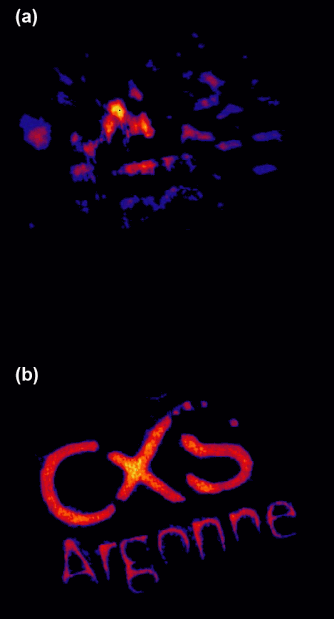Exactly 150 years after the first color photograph was produced, scientists have devised a way of employing the full spectrum of colors from synchrotron and free-electron laser x radiation to image nanometer-sized subjects with unprecedented clarity and speed, and in three dimensions. This new research technique is expected to improve imaging on the nanoscale in the quest for advances in pharmaceutical development and new materials for next-generation technologies.
The researchers, from the ARC Centre of Excellence for Coherent X-ray Science (The University of Melbourne and La Trobe University), SLAC National Accelerator Laboratory, and Argonne National Laboratory used the Argonne X-ray Science Division (XSD) 2-ID-B x-ray beamline at the U.S. Department of Energy Office of Science’s Advanced Photon Source (APS) to develop this new technique, dubbed “polyCDI.”
PolyCDI extends the capabilities of coherent diffractive imaging (CDI), a lens-less imaging technique that has been a mainstay for experiments observing matter on the scale of x-ray wavelengths.
But CDI has its limits. Even though the light from synchrotron x-rays produced at facilities like the APS is the brightest available for research, it is not bright enough to capture precise images at the nanoscale even if exposures are very long, and it cannot be used to capture “movies” of chemical processes, biological changes, and the transformation of materials under stress.
PolyCDI promises to change the game for diffractive imaging. Rather than employing a single wavelength of light from a high-brightness x-ray source such as the APS, polyCDI utilizes broadband light, also available from the APS, that contains many wavelengths at the same time. The results of the group’s research, just published in Nature Photonics, show that polyCDI can produce images almost two orders of magnitude faster than conventional CDI.
Deployed in concert with a new generation of fast x-ray detectors, CDI could make possible the first time-resolved nano-movies of changes to materials brought on by extreme temperatures or high magnetic fields, processes that are vital in developing advanced materials for new technologies. Coupled to innovative focusing optics, polyCDI could greatly reduce the time needed to gather information about the composition of diseased cells.
Professor Keith Nugent, of the University of Melbourne and a member of the polyCDI team, called the discovery an exciting development. “Typically for best imaging, researchers need to convert samples to crystals, but this is not always possible in all samples,” he said. “This discovery of utilizing full color synchrotron light to improve precision and speed of imaging has huge potential.”
Ian McNulty, of XSD and a collaborator on the work, said, "By going 'broadband' this new capability stands to revolutionize x-ray imaging much as the advent of broadband communications technology has changed our lives. We are especially excited about applying it to CDI with higher energy x-rays to peer deeper into dense materials, ultimately to see features on the scale of single atoms."
See: Brian Abbey1, Lachlan W. Whitehead1, Harry M. Quiney1, David J. Vine1, Guido A. Cadenazzi1, Clare A. Henderson1, Keith A. Nugent1*, Eugeniu Balaur2, Corey T. Putkunz2, Andrew G. Peele2, G. J. Williams3, and I. McNulty4, “Lensless imaging using broadband X-ray sources,” Nat. Photo. 5, 420 (published online July 2011). DOI: 10.1038/NPHOTON.2011.125
Author affiliations: 1The University of Melbourne, 2 La Trobe University, 3SLAC National Accelerator Laboratory, 4Argonne National Laboratory
Correspondence: *[email protected]
Use of the Advanced Photon Source at Argonne National Laboratory was supported by the U. S. Department of Energy, Office of Science under Contract No. DE-AC02-06CH11357.
The authors acknowledge the support of the Australian Research Council Centre of Excellence for Coherent x-ray Science and the Australian Synchrotron Research Program.
The Advanced Photon Source at Argonne National Laboratory is one of five national synchrotron radiation light sources supported by the U.S. Department of Energy’s Office of Science to carry out applied and basic research to understand, predict, and ultimately control matter and energy at the electronic, atomic, and molecular levels, provide the foundations for new energy technologies, and support DOE missions in energy, environment, and national security. To learn more about the Office of Science x-ray user facilities, visit http://science.energy.gov/user-facilities/basic-energy-sciences/l.
Argonne National Laboratory seeks solutions to pressing national problems in science and technology. The nation's first national laboratory, Argonne conducts leading-edge basic and applied scientific research in virtually every scientific discipline. Argonne researchers work closely with researchers from hundreds of companies, universities, and federal, state and municipal agencies to help them solve their specific problems, advance America's scientific leadership and prepare the nation for a better future. With employees from more than 60 nations, Argonne is managed by UChicago Argonne, LLC for the U.S. Department of Energy's Office of Science.

